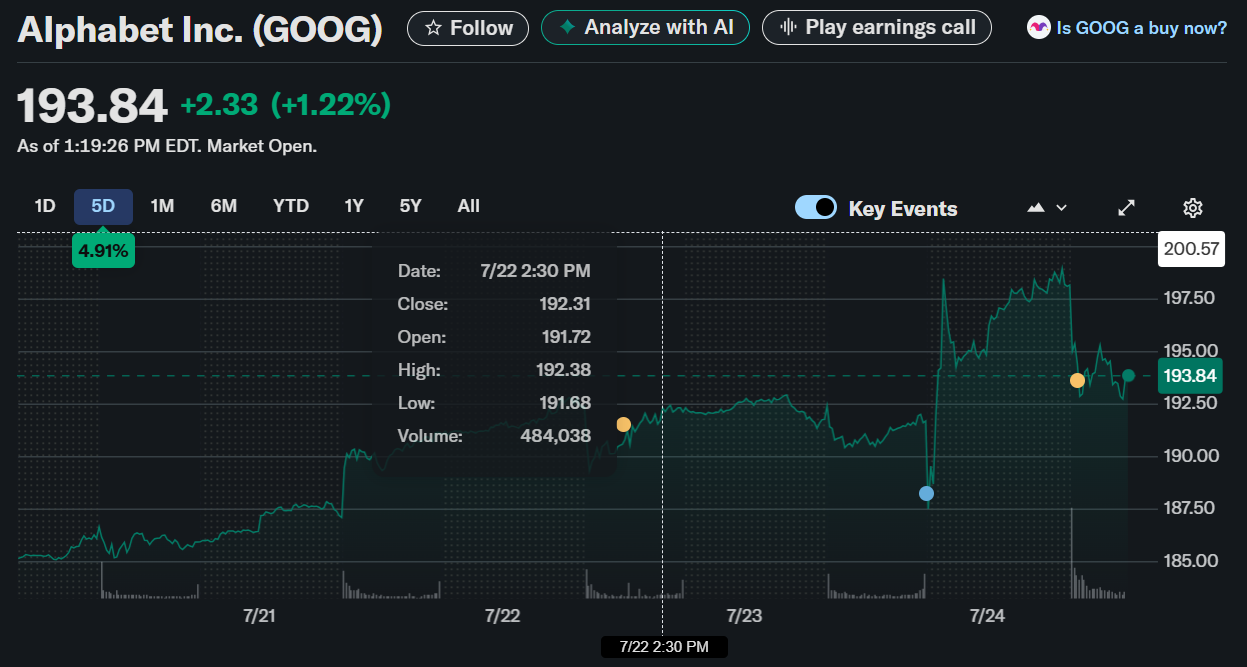$GOOG’s AI Gold Rush: Alphabet Inc. Smashes Earnings, Plows Billions Into AI CapEx Boom
Wall Street's favorite cash printer just found a new slot machine—and it runs on GPUs. Alphabet Inc. ($GOOG) crushed Q2 earnings, then immediately funneled the windfall into an AI infrastructure blitz that'll make Nvidia shareholders weep with joy.
The AI Arms Race Heats Up
No fluffy 'AI-powered future' platitudes here—just cold hard CapEx. Google's parent company is deploying capital like a crypto bull chasing the next shitcoin, except with actual revenue to back it up. The street expected another boring cloud earnings beat. What they got? A full-scale AI industrial complex.
Balance Sheet Jiu-Jitsu
Somewhere in Mountain View, CFO Ruth Porat is performing spreadsheet sorcery—turning ad dollars into AI data centers faster than Sam Bankman-Fried burned through venture capital. The move signals what every tech investor fears but won't admit: search margins are toast without an AI moat.
The Bottom Line
Google proved it can still print money the old-fashioned way (monopolistic ad tech) while aggressively buying its next monopoly. Just don't ask what happens if AI search never becomes profitable—some questions are better left to the next earnings call.
TLDR
- Alphabet Q2 revenue reached $96.43B vs. $94B expected, up 14% year-over-year
- Adjusted EPS hit $2.31, beating estimates of $2.18
- Capital expenditures for 2025 increased by $10B to $85B
- Google Cloud and YouTube ad revenue surpassed forecasts
- Gemini AI and AI Overviews show rapid user growth
Alphabet Inc. (NASDAQ: GOOG) was trading at $193.64 as of midday Thursday after the company delivered a strong second-quarter performance.

Alphabet Inc. (GOOG)
The tech giant exceeded revenue and earnings expectations and surprised investors by announcing a $10 billion increase to its 2025 capital expenditure budget, now totaling $85 billion. The MOVE underscores Alphabet’s heavy commitment to artificial intelligence infrastructure and cloud expansion.
Strong Q2 Performance Across Core Segments
Alphabet reported Q2 revenue of $96.43 billion, well above analyst estimates of $94 billion and a 14% increase from the previous year. Adjusted earnings per share reached $2.31, surpassing the $2.18 consensus. Net income jumped nearly 20% to $28.2 billion.
Google Cloud delivered revenue of $13.62 billion, topping forecasts and marking a 32% increase year-over-year. YouTube ad revenue ROSE to $9.8 billion, above the $9.56 billion estimate, while advertising revenue across all services increased to $71.34 billion, up from $64.61 billion last year. Search revenue came in at $54.19 billion.
$85 Billion CapEx for AI Growth
CEO Sundar Pichai revealed that Alphabet’s 2025 capital expenditures WOULD increase to $85 billion, up from the previous guidance of $75 billion. The increase is driven by growing demand for cloud services and AI infrastructure. Pichai noted that OpenAI would use Google’s cloud platform for ChatGPT, highlighting Alphabet’s increasing role in enterprise AI infrastructure.
Finance chief Anat Ashkenazi stated the company expects even higher CapEx in 2026. She also addressed the growing cost of top AI talent, confirming the firm’s ongoing investment in leading researchers, including a recent $2.4 billion acquisition of Windsurf and its team.
AI Products, “Other Bets,” and Legal Costs
AI Overviews, Google’s AI-powered search summaries, now serve over two billion monthly users, up from 1.5 billion last quarter. The Gemini app, Alphabet’s AI chatbot, has reached more than 450 million monthly active users.
The “Other Bets” unit generated $373 million in revenue but posted a $1.25 billion loss. Alphabet also recorded a $1.4 billion charge related to a privacy lawsuit settlement with the Texas Attorney General.
Analyst Outlook and Stock Performance
Analysts remain bullish on Alphabet. The average 12-month price target is $207.34, indicating roughly 9% upside from the current $193.64. GuruFocus estimates the stock’s fair value at $199.27.
Despite strong results, GOOG shares are up just 1.72% year-to-date versus the S&P 500’s 8.30% gain. Over five years, however, the stock has returned 157%, outperforming the broader index.

